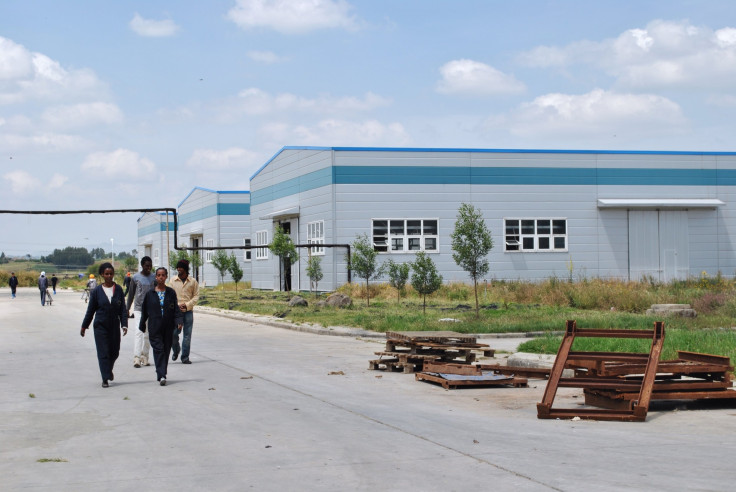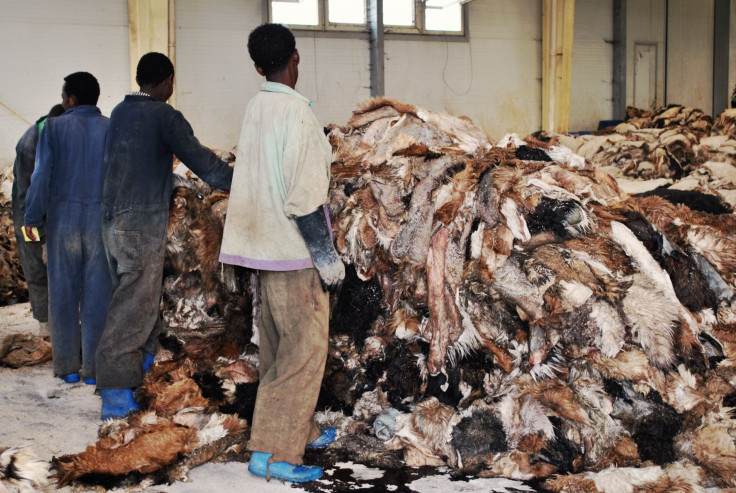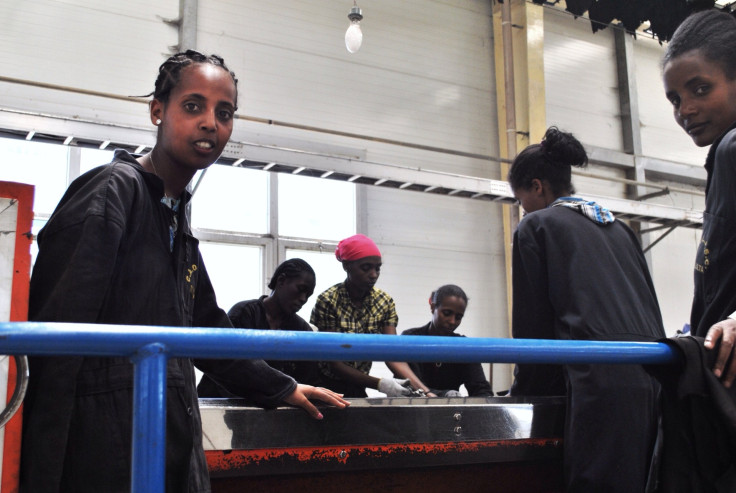An African Manufacturer? Ethiopia Gears Up To Emulate China, Vietnam And South Korea In Factory Output

ADDIS ABABA, Ethiopia -- From the outside, the China-Africa Overseas Leather Products tannery looks eerily idle. Long white buildings with blue-tinted windows surround a nearly empty parking lot, and the facility is so quiet you can hear the fluttering of the Chinese and Ethiopian flags out front.
But inside the gate and down past the office buildings -- where many of the Chinese employees work and live -- is a collection of massive workshops, and there you can hear the whirr of machinery as animal hides are soaked, threshed, tanned, shaved, colored and finished. About 450 Ethiopian workers are there to move things along.
The factory is situated just north of this capital city, in the town of Suluta. That's where most of its employees come from, including Wuberst Desalegn, a 22-year-old woman who has been working at the factory since shortly after it opened in 2010. She has since been promoted to the position of finishing director. Wuberst isn't quite sure where she'd be if she weren't working at the China-Africa Overseas Leather Products facility, she says. Perhaps at home.
"I think maybe I'll stay in this company," she added. She makes 1,400 Ethiopian birr ($74) a month, which easily covers her rent of 250 birr ($13).
The government of Ethiopia hopes that millions more will follow in Wuberst's footsteps. It has plans to turn its economy from a primarily agricultural one (farming makes up 43 percent of GDP and employs about 85 percent of the population) into one where manufacturing plays a larger role.
It's a strategy that hopes to emulate the successes of East Asian countries such as Vietnam, China and South Korea, where wages are rising as manufacturing operations grow ever more sophisticated. Higher costs in Asia could push international manufacturers to move to Africa, where labor costs are minimal and land is relatively cheap. Ethiopia wants to be ready for that influx, and has been saying so for years.
But manufacturing's contribution to GDP has hovered around 4 percent for years; for all their talk, officials haven't been able to nudge that figure upward. Some apparently intractable issues, including a dire lack of financing, shoddy trade logistics and a shallow pool of local experience, will have to be overcome before Ethiopia can realize its dream of emulating Asia's manufacturing boom.

Manning the Machines
The appeal of manufacturing for developing economies is simple: Factory employees have high labor output per capita and can earn far more money than workers in most other sectors.
"It offers prospects for labor-intensive growth," Lars Christian Moller, the World Bank's lead economist in Ethiopia, told IBTimes. "That's in contrast to a sector like natural resource extraction, which has very high value-added but doesn't require a lot of labor. You don't just want growth; you want employment and poverty reduction. The more workers that can be involved in production, the better."
Ethiopia has plenty to attract manufacturers from abroad. Its natural resources, including abundant livestock, thick forests and arable land for cotton, make it perfect for factories churning out leather, wood or textiles. "Ethiopia has some of the best leather in the world," said Ji Bingbo, a marketing officer at the China-Africa Overseas Leather Products tannery. Low wages were also attractive to the company; Ji says most workers make between 700 and 1,000 birr ($37-$53) a month -- rates that are failing to attract laborers in Asia.
Ethiopia, in turn, benefits not only from increased employment but from higher demand for its own products. The tannery in Suluta sources almost all of its raw materials from the country, bringing extra revenue to the livestock and chemical industries.
The Ethiopian government is working to attract investment, both foreign and domestic, said Girma Damte of the Ministry of Industry. "In a few years we intend for the economy to be taken over by the industry sector. We have provided various incentives to investors in the manufacturing sector, like customs exemptions and tax holidays. We are seeing that foreign companies are very glad to invest in the country because of the favorable conditions we have here," he said.
Boosting private enterprise in any sector will be a boon to Ethiopia, which faces an economic turning point. Its Gross Domestic Product growth has averaged 10.6 percent annually during the past decade, a ringing endorsement of the government's state-driven economic policies -- until now. GDP growth slipped to 9.7 percent in the fiscal year ending this July, and the World Bank has projected average annual growth of just 7 percent through 2016.
For a country that boasts the world's third-highest rate of public investment and the sixth-lowest rate of private investment, many economists are urging a sea change in the way Ethiopia pursues growth. Privatization will be key. And while the government has been hesitant to open up sectors like finance and telecommunications, it readily acknowledges that beefing up manufacturing would be an ideal way to spur foreign direct investment and broad-based growth.

Smooth Operator?
Ethiopia will have to overcome some serious bottlenecks before it can realize its ambitions in manufacturing.
"The major problems are a lack of adequate capacity on the part of government offices to organize systematically, and in a manner to be capable of giving one-stop-shop service to investors," said Girma of the Ministry of Industry. "It's a very difficult job."
He points to a number of investor-friendly institutes that are opening up -- one for textiles, one for metals, one for pharmaceuticals and one for agro-processing, to name just a few -- and the hiring of two more state ministers of industry in order to help speed things along. He adds that the new minister of industry, Ahmed Abitew, has engineered some big changes since he was appointed this year.
"What he has done was to have several meetings with both domestic and foreign investors, just to pinpoint the problems they have. And next was to have meetings with stakeholders like electric power authorities, customs and other logistics sectors that can solve these problems."
But meetings and institutes are only the first step; for manufacturers, the problems are plain and simple. They primarily boil down to trade logistics, an area where Ethiopia's performance has actually been dropping over the several years. The World Bank's Trade Logistics Index has seen Ethiopia's rank slide to an abysmal 141 out of 155 countries in 2012, from 104 five years ago.
That means it's taking longer for containers to get to landlocked Ethiopia from its primary maritime port in neighboring Djibouti. It means that roads are bad, infrastructure is lacking and the power often goes out. Operations are not only slowing -- they are incurring extra costs, eating into existing investors' potential profits and discouraging new projects.
The China-Africa Overseas Leather Products, for instance, imports some of its soaking chemicals form China, and Ji says the shipments are expensive and can take more than 40 days to arrive at the facilities in Sululta. (World Bank data corroborates this estimate; by comparison, imports into Rwanda can take only 31 days.) He also says the power goes out frequently, though it doesn't shut down production because operations can manage on back-up generators -- another expense.
To fix these problems, Ethiopia needs money to make the investments. But after years of heavy public spending and successful efforts to bring inflation rates down into the single digits, Ethiopia's domestic savings have dwindled, leaving little for investment in the private sector -- including the manufacturers that Ethiopia covets.
"To invest you need to save, but Ethiopia doesn't have the same savings rate as East Asian countries did," said Moller of the World Bank. "The government is aware of that challenge; it's trying to mobilize savings such that it doesn't have to rely on foreign transfers or foreign borrowing."

Bit by Bit
These problems must be addressed if Ethiopia is to emulate Asian growth, but a favorable trend is emerging in the meantime: Foreign investors are bringing technical know-how and international connections into the country, which will benefit local companies that aim to follow suit.
"Foreign investors are already in a good position; they have enough experience," Girma said. "Many domestic investors have not been exposed to the modern manufacturing techniques, the international market or modern management systems. But that will change, and government will be obliged to give them special support."
It's a learning process -- and it's already working for Wuberst. "This is a good company," she said. "Before, I didn't how to work the leather. But they came and shared the experience."
The hope is that in time, as more foreign investors pour in and all of that technical expertise filters out into the Ethiopian population, industry could become the country's next big boom. That, in turn, would provide a case study for the rest of sub-Saharan Africa, which could replicate Asia's growth if it plays its cards right.
© Copyright IBTimes 2024. All rights reserved.
Join the Discussion





















